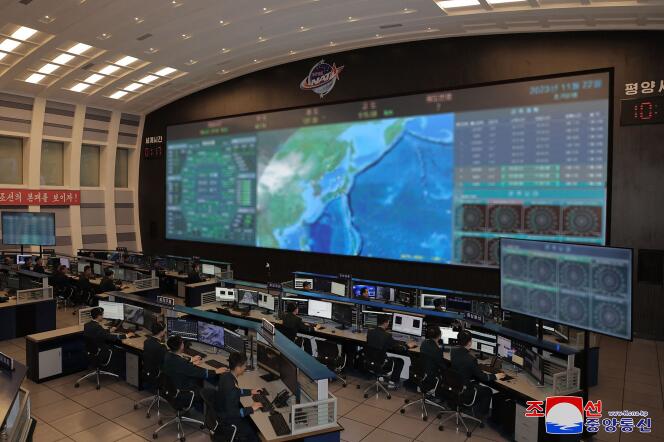After two unsuccessful attempts, North Korea announced, Wednesday, November 22, that it had succeeded in placing its first spy satellite into orbit, which, according to it, allowed leader Kim Jong-un to examine photographs of the main American military bases. of Guam, in the Pacific.
In response to this launch, carried out in violation of UN resolutions, South Korea partially suspended a military agreement with its northern neighbor.
Kim Jong-un “looked at aerospace photos of Anderson Air Force Base, Apra Harbor and other major US military bases, taken from the skies above Guam in the Pacific”, announces the North Korean news agency KCNA. A rocket launched on Tuesday “managed to put the Malligyong-1 satellite into orbit”she had assured a little earlier.
The Democratic People’s Republic of Korea (DPRK), North Korea’s official name, plans to launch more satellites “in a short period of time” in order to strengthen its surveillance capabilities of South Korea, continues the agency, adding that “launching a reconnaissance satellite is a legitimate right of the DPRK to strengthen its self-defense capabilities”.
According to the South Korean military, the satellite does appear to have entered orbit, but it “will take time to determine if the satellite actually works”. South Korea, for its part, plans to launch its first spy satellite, using a SpaceX rocket, before the end of the month.
Vladimir Putin suggested in September, during a meeting with Kim Jong-un, that Russia could help Pyongyang develop its space program. Seoul and Washington later said Pyongyang was supplying weapons to Russia.
Cut lines
Without condemning the launch, China, an ally of Pyongyang, judged the situation “complex and sensitive”. “All parties involved should remain calm and exercise restraint (…) and do more things conducive to easing tensions”declared Mao Ning, spokesperson for Chinese diplomacy, to the press.
North Korea had already tried unsuccessfully to put a satellite into orbit last May and August. Seoul therefore reacted by announcing the partial suspension of the military agreement concluded on September 19, 2018 to reduce tensions along the highly secure inter-Korean border, in particular by creating maritime “buffer zones”.
The World Application
The Morning of the World
Every morning, find our selection of 20 articles not to be missed
Download the app
This suspension could not be notified directly to Pyongyang because “lines of communication with North Korea are cut”specified a spokesperson for the South Korean government cited by Agence France-Presse.
The United States, Japan and the United Nations also condemned the launch.
“Any launch by North Korea using ballistic missile technology is contrary to Security Council resolutions”recalls Farhan Haq, deputy spokesperson for UN Secretary General Antonio Guterres, in a press release.
“Even if they call it a satellite, launching something that uses ballistic missile technology is clearly a violation of UN resolutions”also underlined the Japanese Prime Minister, Fumio Kishida.
This shot is “a blatant violation of multiple United Nations Security Council resolutions, increases tensions and risks destabilizing the region and beyond”for her part, reacted the spokesperson for the National Security Council of the White House, Adrienne Watson.
